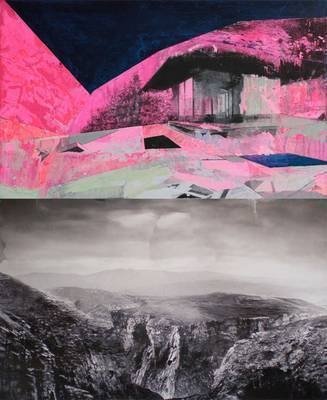Judith Lindner and Ingrid Rodewald
dal 18/3/2010 al 6/5/2010
Segnalato da
18/3/2010
Judith Lindner and Ingrid Rodewald
Uschi Kolb Gallery, Karlsruhe
Somewhere else. Paintings and collages.

The gallery is delighted to present, for the second time, paintings by Judith Lindner and, for the first time, collages by Ingrid Rodewald. In the exhibition andernorts (somewhere else) the works of both former Masters students of the Academy of Fine Arts in Karlsruhe combine images of architecture and landscape under the rubric 'place' whose particular genius loci is constituted by the absent presence of people.
Judith Lindner paints man-made sites as living spaces. These tend to have an aspect of shelters. The world in Judith Lindner's pictures is assembled from rectangular colour planes in strong perspective distortion between two vanishing points lying far outside the picture plane, and in strong contrasts of colour and light/dark. This paving-like structure fills the entire pictorial field, pressing far into the distance and seeming to expand beyond the picture plane into the viewer's space.
In these pictures, people are constantly absent, as if the places have been abandoned. Without the suggestion of a human figure, the dimensions and the relations between the elements remain unclear, the spatiality is imprecise. Also the quality of the material, the underlying structure of the tectonic forms, and the time remain largely undefined. The places, spaces and worlds in Judith Lindner's pictures resemble dream worlds and raise the question: what would it be like to enter them?
The different colour planes painted in numerous glazed layers and precisely set off from one another form planes and (open and closed) stereometric bodies that recall 70s bungalows, concrete partition walls, large glass or closed windowless facades, flat roofs, terraces, adjoining swimming pools. Nature in the form of hedges or individual plants has been allocated an exact place. As soft volumes made up of loose brush strokes, but in an unnatural hue, it billows up from the framework of precisely defined planes, threatening to overrun it.
Colour in Judith Lindner's picture has a strong compositional force. Its colour and symbolic value determine whether an element should be seen as near or far, ground or abyss, wall or expanse. It also has a strong emotional impact. It invites the viewer's gaze either to settle on particular details or be melancholically repelled. The particular resonance of neighbouring colours awakens synaesthetic associations.
While Judith Lindner's early pictures depict urban views, and her current canvases deal with bourgeois habitation, the first small panel pictures now show, in place of the stereometric bodies, organic and archaic forms such as rock formations, crystals and caves. In these new motifs, the deep perspective is abandoned; the once clearly delimited colour fields are now broken into smaller fragments, and the pictorial space seems to be stretched out in front of a dark background. The panels are also more painterly. The constant shifting between collage, paint application and scraping back produces a highly animated surface. These places, including the man-made structures, the ruinous habitation, seem to be in a process of returning to a state of nature. The panels have a narrative force.
Ingrid Rodewald's material is large-format outdoor advertising posters. While her pictures are based on the motifs found in these posters, all the elements contributing to advertisements' messages are removed. She sees the rhetorical instruments of writing, the characters and numbers, as foreign bodies, and covers them over with the torn-off pieces of other posters from the same series. Every reference to non-natural contexts, to the man-made, to civilisation is thereby symbolically excluded.
In a further step, the depiction at the heart of the poster such as a 'mood image' of nature that was once superimposed with messages, is removed, isolated and cleaned up. With an ordering hand, Ingrid Rodewald brings calm to the scene by smoothing out the landscape's silhouette, folding jagged mountains, softening the composition of the landscape formations. At the same time, she implants the carefully sorted fragments – grass with grass, stone with stone, sky with sky – until the resulting representation of nature seems to correspond to an ideal notion of the 'unspoilt', of 'harmony' and 'naturalness' so that these places start to awaken ideas of paradise and thus become projection screens again.
The attempt to liberate the recycled motif from its instrumentalisation in advertising and to return it to its supposedly natural state resembles a therapeutic operation. Clearly, the result raises questions. The pictures' sense of calm is only temporary. The scars of the 'making-good' are still painfully visible. However, As a result of the different halftone in the offset printing process and the resulting differences in the degree of sharpness the implants shimmer and vary in a fascinating way. It thus becomes clear that the world in Ingrid Rodewald's pictures is the result of montage, that it is assembled from facets derived from the history of the material and the motif. This is not a fixed final image in search of a balance of forces.
In Ingrid Rodewald's floor object graswachsen (grass-growing) pieces of a poster printed with the photograph of pebbles cover a wooden board. This resembles part of an exposed-aggregate concrete terrace. However, there is no position from which this uneven form is subordinated to the assumed rectangular perspective construction. This is the result of the works' complex multi-layeredness. The 'grass' under one of the edges seems like an offer to 'imaginatively develop' the place. It awakens associations. It calls on the viewer to draw on their own inner archives of the 'material properties' that typically govern childhood memories.
Rebekka Bücheler M.A.
Opening March 19, 2010, 6-9 pm
Uschi Kolb Gallery
Lorenzstrasse 18 - Karlsruhe
Tue - Fri 11-18 Uhr, Sat - Sun 11-15 Uhr
free admission



